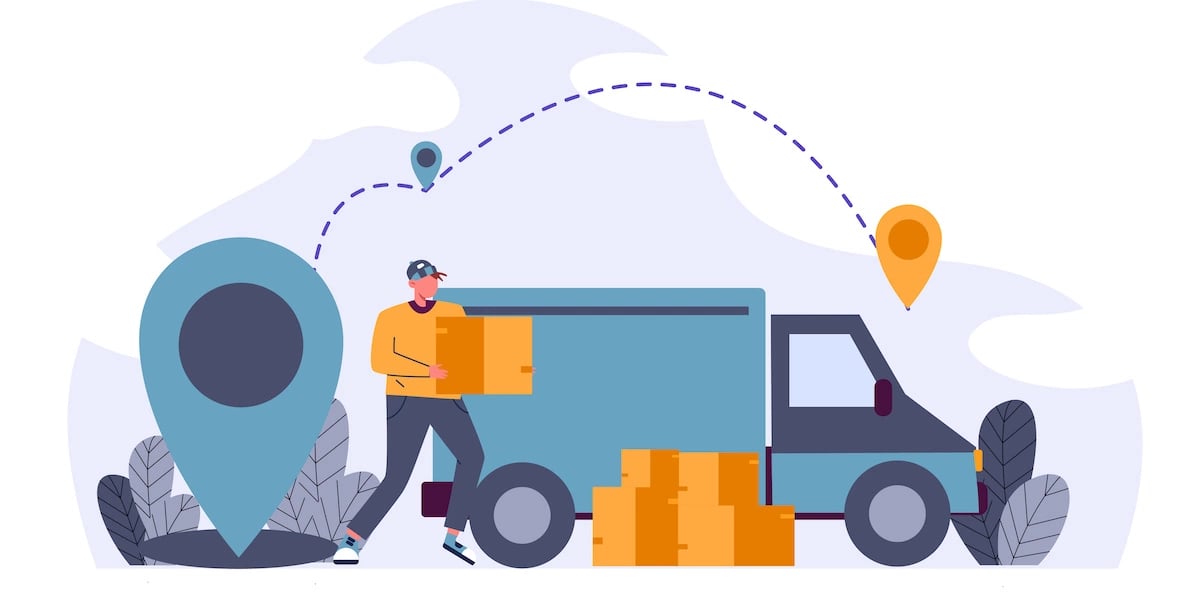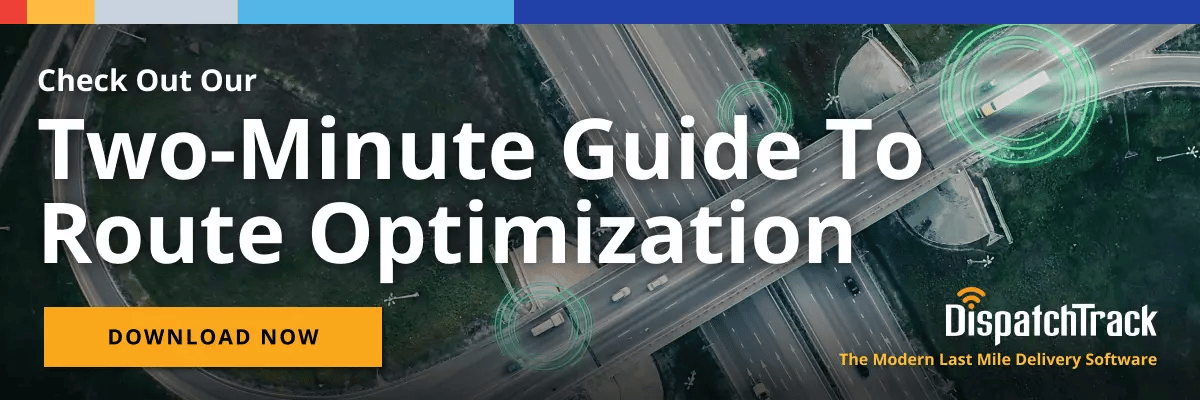Your Guide to Delivery Routing Software
7 Minute Read
Deliveries form a major part of any retail business. Which is why effective route management is more critical than ever for logistics stakeholders in retail and many other industries. After all, slow or inaccurate deliveries can cause customers to turn to competitors.

Of course, the importance of delivery in customer experience isn’t a new concept. But the challenge of ensuring seamless delivery route optimization via conventional methods is significant. Especially given growing order volumes, shrinking driver labor pools, and ratcheting customer expectations. It can be an incredibly daunting process—unless you’re assisted by sophisticated software.
If you plan to adopt new delivery routing and scheduling software, the following points should help you make an informed decision. First, let's take a look at route optimization to get a better understanding of how it impacts modern delivery operations.
The Basics of Route Optimization
Route optimization for finding the most optimal routes for getting the right goods to the right customer at the right time. Basically, it means finding the most efficient and cost-effective paths drivers should take from point A to point B, taking into account factors such as driver speed, traffic congestion, road and weather conditions, one-ways, and more.
Route optimization helps you maximize your capacity utilization by decreasing the time that each delivery takes. Indeed, route optimization is crucial when it comes to reducing delivery turnaround times.
At the same time, modern route optimization needs to account for how well your plans work for your customers. This means working with customer time window requests/self-scheduling. It also means estimating accurate ETAs for all stops in order to reduce late deliveries.
Challenges Associated with Conventional Route Planning
Variations in service time, potential traffic delays, and differences in driver speed and skill. These are just a few variables to take into account when finding the most cost- and fuel-efficient routes. But planning routes based on these factors can be challenging without the aid of a delivery truck routing software.
Old fashioned route planning using pen and paper cannot meet these challenges. Simply put, there’s no way to run through all the possible permutations to see which is the best one. These are some of the challenges associated with traditional route planning:
- Routing requires a lot of manual intervention, increasing time and labor costs
- Delivery planning becomes more challenging and time consuming as businesses scale
- ETAs are difficult to estimate with any accuracy
- Plans are inflexible and difficult to adjust once they’ve been generated
- Additional factors (like time window restrictions) increase complexity exponentially
- The ability to analyze data is limited
In contrast, an intelligent delivery routing system should take into account a host of variables all at once. It can determine the most efficient and cost-effective routes for your delivery teams. And it can do it all automatically, in a matter of seconds.
When it comes to choosing the right delivery routing software, it's important to keep the above pitfalls in mind. You need to find a solution that's going to do more than just make route planning easier. Rather, it should transform your route planning into an integrated process that drives real business value.
In all likelihood, this will mean looking at highly-connected SaaS-based technology. In this way, you can prioritize speed and connectivity for your solution. At the same time, you might be looking for solutions powered by AI and machine-learning.
But, at the end of the day, your top priority is to find something that makes efficient routes the norm.
How a Delivery Routing System Helps Transform Last Mile Delivery
Your delivery teams can save time through smart automation and artificial intelligence-backed routing and scheduling software. When your commercial truck routing software can route thousands of stops efficiently in seconds, can carry out more stops per route.
This can pave the way for great delivery experiences. You can back up your consistent on-time delivery via texts and emails at each step of the way. You can also update ETAs in real time, ensuring that your customers know exactly when the truck is due to arrive.
Here are just a few of the benefits you can get from the right delivery routing system:
Automated route planning
The shortest routes might not always be obvious to the naked eye. But with powerful machine learning algorithms, modern delivery routing software can dynamically recommend the most efficient delivery routes. This can save your fleet both time and money via increased efficiency. What’s more is it can do it all with minimal human intervention.
The trick here is to find something that can handle a large number of different parameters and still generate feasible routes. Your delivery routing software should be able to handle time window requests and delivery site specific requirements. It should also be able to account for differences in driver skill, vehicle capacity, and load type.
These sorts of details turn route optimization from a process you can eyeball to a process that requires software. They create a level of complexity that your technology should be able to deal with automatically. Once the parameters have been added into the system, it should produce route plans that actually work.
Improved customer experience
Modern route planning solutions can leverage AI and machine learning to improve performance. Specifically, they can use these new technologies to predict delivery arrival times more accurately than ever before. Needless to say, this can have a huge impact on customer experience.
Studies have shown that showing up at the right time is one of the most important aspects of a successful delivery. But legacy technology (to say nothing of manual routing) makes this difficult. When you can't account for fine-grained details about traffic and service time, you can't predict hyper-accurate ETAs.
But with the right technology, you can achieve 98% ETA accuracy. From there, a world class customer experience begins to fall into place. You can make promises via delivery notifications and actually back them up with performance.
Not only does showing up at the right time delight customers, it also reduces they odds that they won't be home. That means fewer re-delivery attempts and less time spent on the phone with customers trying to reschedule. In other words, the entire last mile runs more smoothly, benefiting you and your customers tremendously.
Later order cutoffs
One of the biggest differences between conventional route planning and modern planning is speed. The best routing solutions enable you to generate routes for thousands of stops in a matter of seconds. Simply put, this can be a game-changer.
For starters, faster routing enables you to move your order cutoff back. Rather than receiving last-minute orders late in the day and wondering how you're going to deal with them, you can just let the routing engine take them in stride. When you don't have to wait for your routes to run overnight, you can gain much greater flexibility. The result is that you can delight your customers by handling late or last-minute orders with ease.
Real-time updates
Your deliveries shouldn't be hampered by the unexpected. Your route planning app should take into account customer preferences, resource capacity, and weather and traffic conditions. And based on that it should be able to determine the most efficient and cost-effective routes.
From there, you should be able to generate accurate ETAs based on real-time route information about from the field. When something’s not going according to plan, you should have the ability to quickly update your route without losing efficiency.
This puts you in a position to manage delivery exceptions in real time, boosting customer satisfaction in the process.
Smarter driver management
Smart software automates the allocation of delivery tasks to drivers in part to eliminate human error. It also helps increase efficiency and can relieve your last-mile logistics partners of burdensome tasks. But only if there’s a clear bridge between delivery planning and delivery execution.
Deliveries are more productive, traceable, and manageable with a mobile app that connects drivers with dispatchers and managers. When you can see what the driver is doing, you can make sure that your route plans are actually being carried out. If they’re not, you can spot it quickly and figure out how best to resolve the situation.
Better integration with other logistics processes
Route optimization is critical for getting the right goods to the right place at the right time without losing efficiency. But it's also not a process that can exist in a vacuum. It needs to integrate with other processes like customer communication and strategic planning.
Unfortunately, it's all too easy to find yourself in a position where routing happens in a vacuum. When your routing system doesn't connect seamlessly with other processes, you run a real risk of this kind of disconnect. In these cases, you can wind up with routes that are hard to execute. Either they don't reflect real-world conditions, or they they simply don't make sense with existing workflows.
When your route optimization is part of a cohesive, connected last mile delivery solution, however, you can ensure this doesn't happen. You can route with the most up-to-date order and client information. And you can seamlessly turn use the ETAs generated by your routing engine to inform delivery communications with customers.
As the delivery unfolds, you can monitor each route in real time to update delivery ETAs based on the latest information. Your routing engine, working in the background to continuously adjust these ETAs, thereby helps you spot exceptions.
Electronic proof of delivery
File this one away under “route execution” as well. Modern route optimization software also enables delivery teams to gather electronic proof of delivery through images and signatures. This can include a timestamp and geostamp as well. In this way, you can document deliveries clearly and get your drivers paid faster.
At the end of the day, the right technology shortens delivery turnarounds and reduces miles driven per day. A robust routing system for delivery also offers seamless communication, real-time final mile tracking, and automatic updates. All these help give customers a great experience and make operations more profitable.
You may also like
Subscribe now
for a weekly blog digest containing growth tips, industry updates, and product announcements!
